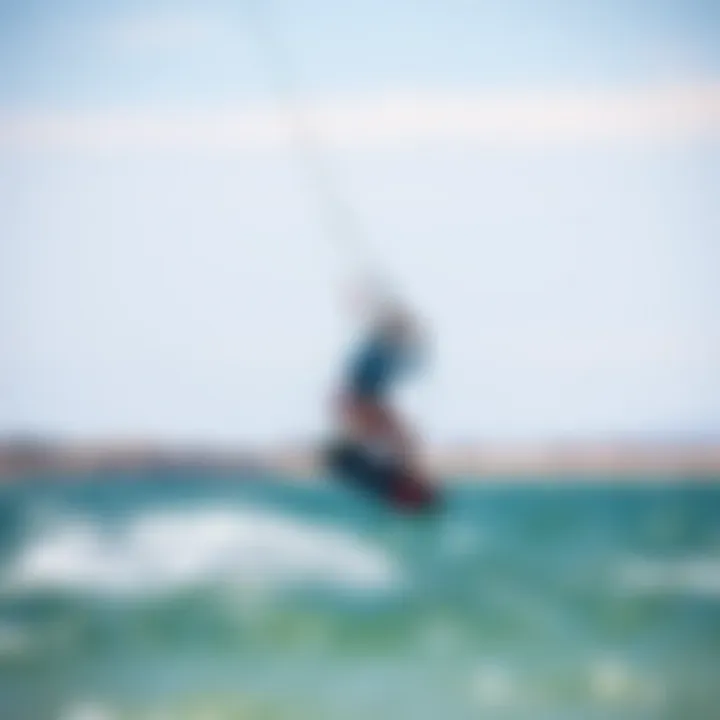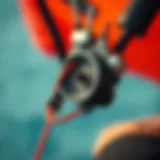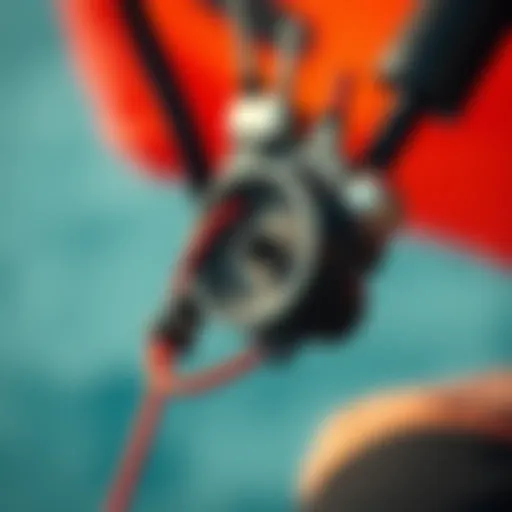In-Depth Analysis of Utah's Weather Map Forecast


Intro
Understanding Utah's diverse weather conditions can be a tricky business, especially for those with outdoor inclinations. Whether you're a kiteboarder waiting for that sweet gust of wind or simply planning a weekend excursion, grasping the local weather intricacies plays a critical role. Accurate weather forecasts aren't just nice to have; they can be the difference between a thrilling adventure and a day spent hiding from rain under a flimsy tent.
In this article, we’ll peel back the layers of Utah’s weather map forecasts, diving headfirst into how various patterns and seasonal changes interact with outdoor activities, particularly kiteboarding. With summer bringing the promise of vibrant blue skies and winter creeping in with temptations of snow, the state's meteorological shifts have a direct impact on enthusiasts.
We’ll also take a look at the sophisticated technology available today, which allows forecasters to predict with greater precision than ever. This readability can empower adventurers to make informed decisions about their activities. Let’s embark on this journey through the highs and lows of Utah’s weather landscape, ensuring you're well-equipped for your next adventure!
Foreword to Utah's Weather Variability
Weather in Utah can be as unpredictable as a cat in a room full of rocking chairs. This unpredictability is central to understanding the state's climate behaviors and the implications they hold for interests like kiteboarding.
Utah features a diverse landscape, which results in a range of microclimates across its regions. From the arid deserts of St. George to the mountainous areas around Salt Lake City, the weather can change in the blink of an eye. Such variability not only impacts daily life but plays a crucial role for outdoor enthusiasts who need to plan their activities carefully.
Understanding Utah's weather variability is beneficial for several reasons:
- Safety: For kiteboarders, having an accurate grasp of evolving weather patterns can mean the difference between a thrilling day on the water and finding oneself caught in risky conditions.
- Planning: Individuals wishing to make the most of their outdoor adventures need reliable forecasts to time their outings perfectly. Knowing when to go is as vital as knowing where to be.
- Adaptability: With climate change nudging weather into uncharted territories, awareness of local patterns can help adventurers adjust their plans or even learn new skills.
When dissecting Utah's weather nuances, one can’t ignore seasonal trends, regional differences, and the interplay of various atmospheric factors. For instance, while winter may blanket the northern regions with snow, southern parts bask in milder conditions, allowing different types of kiteboarding experiences. It’s also worth noting that sudden temperature shifts can lead to strong winds, affecting kiteboarding conditions dramatically.
“Understanding local weather patterns isn’t just about knowing if it will rain; it’s about being prepared for whatever Mother Nature throws your way.”
By taking a deep dive into the intricacies of Utah's weather landscape, kiteboarders and outdoor enthusiasts will be better equipped to embrace—or at least dodge—whatever comes their way, ensuring safety and enjoyment in their activities. In the next sections, we'll delve into how weather maps serve as vital tools for navigating these changing conditions.
Understanding Weather Maps
Understanding weather maps is crucial for anyone interested in outdoor activities like kiteboarding in Utah. These maps distill complex meteorological data into visual formats that are easier to interpret and act upon. This article aims to break down various types of weather maps, their significance, and how they can enhance one’s experience outdoors.
Types of Weather Maps
Weather maps come in various forms, each tailored to present specific meteorological data in a user-friendly style. Here, we will delve into three core types: Radar Maps, Satellite Maps, and Temperature Maps.
Radar Maps
Radar Maps are like the hawk’s eye over the skies. They offer real-time data on precipitation and storm movements, showing where rain or snow is falling. Their key characteristic is the ability to detect moisture, enabling earlier warnings about incoming weather systems. This feature is especially beneficial for kiteboarders because knowing when to expect a storm can make all the difference between a thrilling session or a drowned kite.
One unique aspect of Radar Maps is their high accuracy in showing precipitation levels. However, they may have limitations with clear skies, as they focus primarily on rain and do not fully capture wind patterns. So, while they paint a vivid picture of what’s wet, they might leave you guessing about what’s blowin’ in the wind.
Satellite Maps
Satellite Maps take a broader perspective, capturing large-scale weather patterns from thousands of miles above the Earth. These maps illustrate cloud cover, atmospheric conditions, and temperature distributions over wide regions. The primary advantage of Satellite Maps is their ability to provide a comprehensive view, allowing for big-picture analysis that can help in planning kiteboarding trips.
One useful feature is the visualization of cloud movements, which offers insights into potential weather shifts. However, the downside is that they do not show detailed localized conditions, which can lead to misleading conclusions if you assume a clear sky means a good day on the water.
Temperature Maps
Temperature Maps focus specifically on temperature variations across the region. They are essential for planning kiteboarding sessions, as specific temperature ranges can dictate wind conditions and potential weather transitions. The standout quality of Temperature Maps is their ability to show gradients, helping users identify warmer or cooler zones quickly.
A unique aspect is their role in predicting fronts, which is valuable when assessing conditions for your sport. That said, Temperature Maps don’t necessarily indicate wind strength or direction, meaning kites and adrenaline can await misinterpretation when one does not factor in additional maps.
How to Read a Weather Map
Understanding how to read a weather map can greatly enhance your ability to utilize these tools effectively. Key components often include symbols, legends, and color codes that signify different weather conditions.
Key Symbols
Key Symbols are the shorthand used on weather maps to convey information quickly and clearly. They represent various weather phenomena, from rain to snow, clouds to thunderstorms. Their importance lies in their universal recognition, which allows users to interpret maps swiftly.
The standout feature of these symbols is how they condense complex data into easily digestible icons. The downside lies in potential confusion for those unfamiliar with the symbols�—knowing what a swirly icon signifies can save you from a nasty surprise on the water.
Legend Interpretation
The Legend on a weather map elucidates the meaning behind the symbols used. It translates the sometimes cryptic language of meteorology into something comprehensible. Understanding the legend can prevent misreading a storm for a sunny day, which is crucial for outdoor planning.
What makes the Legend indispensable is its comprehensive nature, helping users connect symbols with real-world conditions. However, reliance on it requires that one takes the time to look—ignoring it might lead to misinformation.


Color Codes
Color Codes translate temperature ranges and weather severity into a visual format that’s easier to grasp. For example, warmer colors might indicate heat, while cooler tones can signify cold fronts. This color differentiation makes understanding weather conditions straightforward and intuitive.
The unique advantage here is the immediate recognition that can come with color interpretations. However, color blindness, or metaphorically blind eyes, might miss the nuances in those shades, leading to misinterpretations in forecasts.
Understanding weather maps is not just about reading them, but also about interpreting the messages they convey in a practical way. Awareness of the different types, symbols, legends, and color codes empowers adventurers to navigate the ever-changing Utah weather landscape. By getting a grip on these elements, kiteboarders and outdoor enthusiasts can make informed decisions, enhancing both safety and enjoyment on the water.
Seasonal Weather Trends in Utah
Understanding the seasonal weather trends in Utah is more than just a basic interest; it’s a vital piece of the puzzle for outdoor enthusiasts, particularly kiteboarders. The state, known for its diverse landscapes and unique climate variations, experiences significant shifts throughout the year that directly influence kiteboarding conditions. From the foot-deep winter snows to the unyielding summer heat, knowing these seasonal patterns can enhance the safety and enjoyment of kiteboarding adventures.
Each of Utah’s seasons brings its own weather characteristics, ranging from heavy snowfall in winter, spring rains, and lightning storms in summer, to the crisp winds of autumn. These elements play crucial roles in not only the preparation for trips but also in determining the best times for kiteboarding.
Winter Weather Patterns
Snowfall Predictions
Snowfall in Utah can be quite a reveal of the state's winter climate. With the mountains receiving bountiful snow, forecasts are often high on the agenda for many outdoor activities. Snowfall predictions help enthusiasts gauge the amount of accumulation expected in the mountains. This crucial aspect allows kiteboarders to plan trips that might take them to frozen lakes or areas where snow-kiting is possible.
One key characteristic of snowfall predictions in Utah is their reliability. Established forecasting models take into accounts local geographic features, leading to more accurate predictions. This reliability makes it easier for adventurers to anticipate favorable conditions. However, a unique feature of such predictions is the stark variability — a predicted significant snowfall may sometimes falter, leaving enthusiasts scrambling for alternative plans.
Temperature Fluctuations
Temperature fluctuations during winter can also tell a story. While snow can pile high, the temperature varies widely, affecting how thick the ice becomes on lakes. Kiteboarders must recognize that as daily highs and lows change, it influences when it’s safe to venture onto frozen bodies of water.
The importance of monitoring these fluctuations cannot be overstated; temperatures can shift from mild to frigid in a day. The more localized weather maps that show current conditions help in making last-minute decisions that can mean the difference between fun and frustration.
Spring Transitions
Rainfall Trends
As winter melts into spring, the weather patterns evolve quickly. Rainfall trends during this period are critical, as they can signal changes in water levels at popular kiteboarding locations like the Great Salt Lake. High levels of rain can flood areas, creating ideal conditions for kiteboarding with smooth surfaces, while a lack of rainfall can lead to muddy or shallow conditions unsuitable for kiteboarding.
One notable characteristic of spring rainfall is its unpredictability, much like a flip of a coin. Planning outings during this season means keeping a close eye on forecasts and always being ready to pivot. A promising sunny morning can quickly morph into afternoon showers, dramatically altering the landscape.
Temperature Gradients
Temperature gradients in spring are another crucial factor influencing kiteboarding. As warmer air collides with residual cool air from winter, it creates interesting thermal conditions suitable for various outdoor activities. This translates into vibrant, consistent winds often sought after by kiteboarders.
The fascinating aspect of these temperature gradients is that they can create consistent thermals, providing excellent conditions for performance. However, during the transition from cool to warm, hang onto your hats; gusty winds can also catch many off guard, affecting flying stability.
Summer Heat and Storms
Thunderstorm Possibilities
In the height of summer, thunderstorms can become frequent visitors in Utah. Thunderstorm possibilities can change the game entirely for kiteboarders. Knowing when these storms are due to cross is vital for anyone considering a mud puddle for a session.
What makes thunderstorms particularly interesting in this region is their sudden onset. They can blow in from nowhere, catching the unaware kiteboarder at sea or out on the lake. This unpredictability is crucial for planning; kiteboarders should always be mindful and equipped with real-time weather updates to avoid dangerous storm conditions.
Heatwaves
During summer, one must also contend with heatwaves. High temperatures create oppressive conditions that might limit kiteboarding opportunities, especially in mid-afternoon. However, moderate to high winds can sometimes offset those soaring temperatures, making early mornings or late afternoons ideal for kiteboarding.
The challenge here is to find that sweet spot between avoiding the heat and catching the best wind patterns. Knowing how these heatwaves interact with local weather phenomena helps kiteboarders decide the best times to hit the water.
Autumn Changes
Cooling Temperatures
As autumn arrives, temperatures begin their descent; cooling temperatures signal the beginning of a change in kiteboarding conditions. The fall chill can usher in a stark contrast from the summer heat, promoting a sharp increase in kiteboarding friendly winds.
Cooling temperatures also indicate shorter days. Kiteboarders need to be mindful of the diminishing daylight hours, especially in preparing equipment and monitoring when to pack up. The crisp air can sometimes invigorate conditions but can drop suddenly, affecting water temperatures and overall safety.
Wind Patterns


Wind patterns become critical in autumn. The shifts from warm summer air to cooler fall air can create unique wind conditions favorable for kiteboarding. Understanding these wind patterns aids in choosing the right time and location for outings.
While the beauty of autumn can be alluring, adventurers must recognize that these shifting wind patterns can sometimes lead to unpredictable conditions. Ignoring wind forecasts can turn a relaxing kiteboarding trip into a swirling adventure; thus, keeping tabs on wind velocity and direction becomes paramount.
Understanding these seasonal weather trends in Utah not only enriches the experience of kiteboarding but also emphasizes the need for thorough preparation and awareness of changing weather variables. For anyone serious about kiteboarding, being attuned to how these seasons influence conditions can lead to more enjoyable and safer outings.
Impact of Weather on Kiteboarding
Weather plays a pivotal role in kiteboarding, influencing not only the enjoyment but also the safety of this thrilling water sport. For kiteboarders, understanding how various weather conditions affect the water and wind is essential. The right weather can make the difference between a fantastic experience and a troublesome outing.
Optimal Weather Conditions
Wind Speeds
Wind speed is arguably the most crucial factor for kiteboarding. Generally, wind speeds between 10 to 20 mph are favorable for both beginners and seasoned kiteboarders. These speeds allow for smooth rides while avoiding the rough conditions that can arise with winds over 25 mph. The ideal wind should also be steady; fluctuating wind can make it difficult to control the kite and can even lead to dangerous situations.
Kiteboards are designed to harness the power of the wind, and understanding its characteristics can greatly impact performance. For example, lighter winds may not lift the kite high enough, leading to sluggish rides, while stronger winds can create exhilarating speed but come with the risk of losing control. Furthermore, local factors such as geographical features can affect wind patterns, making particular spots more favorable.
A unique feature of wind speed is its variability at different times of day. For instance, many kiteboarders prefer afternoon sessions when winds tend to pick up. An understanding of the timing can optimize the kiteboarding experience, enhancing both safety and enjoyment.
Water Temperatures
Water temperature is another essential aspect for kiteboarders. Warm water, typically above 70°F, makes for a more comfortable experience. On the flip side, colder water can make kiteboarding less enjoyable, and can even pose physical risks if proper gear isn't worn. Specific areas in Utah have varying water temperatures influenced by the season and environmental factors.
Understanding water temperature helps in planning gear and safety measures, especially for long periods spent on the open water. A notable advantage of warmer water is added flexibility in terms of equipment; lighter gear allows for better movement and agility. Conversely, colder temperatures might require thicker wetsuits, which can hinder performance.
Weather-Related Risks
Stormy Conditions
Stormy conditions can pose significant risks to kiteboarders. Harsh storms often bring strong winds and sudden changes in weather that can catch kiteboarders off guard. The unpredictability of storms can lead to dangerous situations, including high waves and severe winds.
Experienced kiteboarders know to always check the forecast before heading out. Safety should always be prioritized; if storm warnings are present, it’s best to postpone the outing. Being informed about potential stormy weather can prevent accidents and ensure a safer experience on the water.
Visibility Issues
Visibility can become a major concern during overcast days or storms. When visibility decreases due to weather conditions, kiteboarders may find it challenging to navigate and spot other watercraft. This could lead to collisions or unsafe situations.
Adequate visibility ensures that kiteboarders can fully enjoy their sport while maintaining safety. Some kiteboarders might prefer certain times when weather conditions are clearer, allowing for better visual acuity. On the other hand, decreasing visibility might require adjustments in technique and keener awareness of surroundings.
"A good kiteboarder won't just rely on the wind, but also the weather as a whole. To ride safe is to ride smart."
In summary, kiteboarding is heavily influenced by weather conditions. Understanding wind speeds and water temperatures is critical for enhancing enjoyment and ensuring safety. At the same time, being aware of stormy conditions and visibility issues is imperative for preventing risks. Whether one is a novice or a veteran, keeping an eye on the weather can enhance every kiteboarding trip.
The Role of Technology in Weather Forecasting
In the fast-paced world of outdoor activities like kiteboarding, keeping abreast of weather changes is vital. That's where technology steps in, playing a crucial role in weather forecasting. Modern advancements enhance the precision of forecasts, allow adventurers to better plan their outings, and minimize the risks associated with sudden weather variations. If you're a kiteboarder, having access to real-time weather insights can make the difference between an extraordinary day on the water or a hazardous one.
Advancements in Forecasting Tools
Predictive Models
Predictive models serve as the backbone of contemporary weather forecasting. By using complex algorithms that analyze extensive sets of data, these models can simulate atmospheric conditions. One of the defining characteristics of predictive models is their capability to process vast amounts of information quickly. This rapidly changing data—encompassing temperature, pressure, humidity, and more—contributes significantly to the forecast’s accuracy.
A notable feature of predictive models is their ability to provide long-term forecasts and local updates. For kiteboarders in Utah, this means understanding not only the weather today but also what to expect in the coming days. However, they aren't without their drawbacks; shifts in atmospheric conditions can lead to unexpected forecast changes, potentially leading to over-reliance on long-term predictions.
Real-Time Data
Real-time data has transformed how weather conditions are monitored and reported. This aspect hinges on the rapid flow of up-to-the-minute information collected from various sources like radars and buoys. Its key characteristic is timeliness—providing immediate updates helps adventurers assess current conditions directly. For kiteboarding trips, understanding shifts in wind patterns or sudden changes in temperature can greatly influence safety and fun on the water.
The unique advantage of real-time data is its ability to provide immediate feedback on weather changes. Still, one must consider that such data can be sporadic or affected by local anomalies, which occasionally results in less reliable predictions during rapid shifts.
Reliability of Predictions
Accuracy Rates


Accuracy rates are paramount in establishing trust in weather forecasts. They represent the percentage of time forecasts are correct based on historical data. High accuracy rates are a chief concern for outdoor enthusiasts who count on precise forecasts to plan their activities.
One outstanding feature related to accuracy rates is their validation through historical trends and data correlations. This described reliability breeds confidence for kiteboarders planning an outing. Yet, it’s worth noting that despite advanced technology, certain unpredictable weather phenomena can still skew accuracy edifications.
Forecasting Challenges
Despite advancements, forecasting challenges remain prominent in predicting the weather. These include limitations in data collection, regional variations, and the inherent complexities of weather systems. One critical characteristic of forecasting challenges is their nature: unpredictable fronts, local systems, and rapid weather changes can complicate even the most sophisticated models.
Acknowledging these challenges helps kiteboarders maintain realistic expectations. Understanding that weather is often capricious and that even the best models can falter provides a more balanced viewpoint. While technology greatly enhances forecasting, it's essential for enthusiasts to remain adaptable and prepared for unforeseen conditions.
Using Weather Maps for Planning Kiteboarding Trips
Planning a kiteboarding trip in Utah can be quite an adventure, but it hinges on understanding the local weather. Weather maps serve as a crucial tool for kiteboarders, offering insights that can make or break your day on the water. By utilizing these maps, kiteboarders can anticipate conditions like wind speeds and water temperatures, both of which directly impact performance and safety on the water. The ability to read these maps empowers you to choose the optimal times and locations for kiteboarding, thus enhancing your experience.
Choosing Locations Based on Forecasts
Top Kiteboarding Spots
When considering where to kiteboard in Utah, a few prime locations stand out. Places like Bear Lake, Utah Lake, and Jordanelle Reservoir are well-known among the kiteboarding community. Each of these areas boasts unique characteristics tailored for the sport.
- Wind Patterns: For instance, Bear Lake is famous for its consistent wind patterns, making it a favorite among seasoned kiteboarders.
- Scenic Views: On the other hand, Utah Lake offers stunning mountain backdrops, which can make your session more picturesque and enjoyable.
Furthermore, these spots typically feature ample space for launching and landing kites, crucial for safety and ease of access. However, wind conditions can vary greatly, so checking the forecast is paramount.
"Choosing the right location in Utah can mean the difference between an exhilarating experience and a frustrating one."
Accessibility Considerations
Another essential aspect is accessibility. Assessing how easy it is to reach a kiteboarding location can affect your plans significantly.
- Proximity to Amenities: Locations like Utah Lake have nearby facilities such as parking, restrooms, and rentals, which add convenience to your outing.
- Transportation Access: Consider how long it takes to get there; is it on a well-maintained road or a bumpy dirt path? Less accessible spots might offer great conditions but could require extra time and effort to get to, which might not be ideal if you're limited on time.
By weighing these accessibility factors, you can ensure you'll spend more time on the water and less time worrying about logistics.
Timing Your Outings
Good timing is key when it comes to kiteboarding. Wind patterns can flux throughout the day, as can temperature and visibility. Understanding when to hit the water can maximize your experience.
Morning vs Afternoon Sessions
There is often a debate among kiteboarders about whether morning or afternoon sessions are better. On one hand, mornings can offer gentler winds and cooler temperatures, making it ideal for learners or those looking for a more relaxed outing.
- Wind Consistency: Many places experience calmer winds in the morning, which can be perfect for practice.
On the other hand, afternoons often bring stronger winds, beneficial for more experienced riders looking for thrills. However, with increased wind speed comes the need for heightened safety awareness – conditions can change rapidly.
Weekend Plans
Weekends tend to attract more riders to popular spots, which is something to keep in mind. If you're planning a trip during Saturday or Sunday, you might face crowded conditions. Yet weekends also typically promise better wind patterns in many locations, as weather systems tend to stabilize.
- Timing for Cheer: This influx of fellow enthusiasts can create a vibrant atmosphere, making it a great opportunity for socializing and learning from others.
To wrap it all up, effectively utilizing weather maps can elevate your kiteboarding experience in Utah. They not only inform about the best spots but also the optimal timing to hit the water, offering a smoother sailing regardless of your skill level. Don't overlook the nuances of local conditions; they could be the key to your next great adventure.
Ending and Future Prospects
In wrapping up our exploration of Utah's weather forecasting, it's essential to underscore the significance of comprehending both the immediate and future implications surrounding these forecasts. The weather in Utah is not just a prediction; it serves as a pivotal guide for adventurers and kiteboarders alike. As climates shift and technology evolves, understanding how these factors intersect becomes paramount. This ensures safety while maximizing enjoyment during outdoor activities.
The Future of Weather Forecasting in Utah
Emerging Technologies
The realm of emerging technologies represents a significant leap in the quality of weather forecasting. Innovations like artificial intelligence and machine learning contribute to better prediction models that can analyze vast amounts of data rapidly. One key characteristic of these technologies is their ability to process real-time information, allowing for more localized forecasts. This becomes a highly valuable asset for kiteboarders looking for precise wind conditions.
One particularly unique feature is the integration of user-generated weather reports from apps like Windy.com, where enthusiasts share up-to-the-minute conditions. Such real-time data creates a community-driven approach that enhances the reliability of forecasts. However, it’s important to also recognize the challenge of overly dependent on technology, which may sometimes overlook the nuances that human experience can bring to understanding weather patterns.
Climate Change Implications
Climate change casts a long shadow over weather forecasting and presents its own distinct set of implications. The rising temperatures and shifting precipitation patterns directly influence the reliability of weather maps. An important characteristic of this element is its unpredictability; with climate change, the guidelines that once governed forecast accuracy may not hold up as they once did. This unpredictability can lead to a false sense of security among adventurers who may misinterpret shifting weather conditions.
One unique aspect of climate change is the intensification of weather events. Increased storm activity and erratic weather can create serious risks for kiteboarding, requiring environmental awareness and contingency plans. While this presents disadvantages, it also highlights the need for more robust and adaptable weather forecasting systems that can respond to changing climates. Enlisting the use of technology in monitoring and understanding these shifts could ideally result in smarter planning and safer outings for kiteboarders and outdoor enthusiasts.
Understanding future weather forecasting and climate change implications can shape better strategies for kiteboarding and outdoor activities in Utah, fostering enhanced safety and enjoyment amidst changing conditions.















